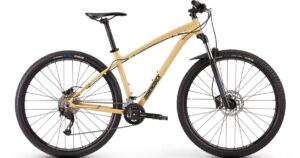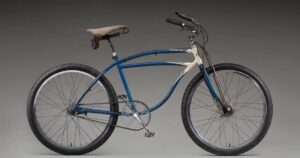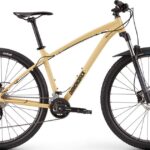Shifting gears on a Huffy mountain bike involves adjusting the bike’s gears to change the effort needed for pedalling. It allows riders to tackle different terrains by making pedalling easier or harder. By shifting gears you can adapt to inclines or flat surfaces optimising your riding experience for comfort and efficiency.
Looking to conquer trails effortlessly? Discover how to shift gears on a Huffy mountain bike and unlock a smoother ride! Unveil the secrets to mastering terrain changes with ease by learning the art of gear shifting. Ready to elevate your biking experience? Let’s dive in and demystify how to seamlessly navigate those inclines and flats!
Unlock the secrets to maximising your Huffy mountain bike’s performance! In the next few lines we’ll break down the steps to smoothly shift gears ensuring a seamless ride on various terrains. Stay tuned to gain insights that’ll revolutionise your biking experience and elevate your skills effortlessly.
Understanding Your Huffy Mountain Bike
Getting familiar with your Huffy mountain bike opens the door to an exciting biking adventure. From its sturdy frame to the intricate gear system, understanding the components ensures a smoother ride. Learn about the bike’s features, like the suspension brakes and gear shifts to navigate trails confidently and make the most of your cycling experience.
Exploring your Huffy mountain bike’s anatomy provides the foundation for a thrilling ride. Delve into its design explore how each part contributes to performance and grasp the mechanics behind a comfortable, efficient journey. Understanding your bike lays the groundwork for a safer, more enjoyable exploration of various terrains.
The Significance of Proper Gear Shifting
Efficient gear shifting on a mountain bike isn’t just about convenience; it’s the key to an enjoyable and safe ride. Proper gear changes optimise pedalling effort, helping riders conquer challenging terrains with ease while reducing strain on muscles.
Mastering this skill ensures a smoother ride improves bike handling and maximises the bike’s capabilities enhancing the overall biking experience. It’s not just about changing gears; it’s about unlocking the true potential of your mountain biking adventures.
“From navigating steep inclines to cruising along flat paths, understanding the significance of correct gear shifting like fixing the chain on a mountain bike transforms the way riders tackle diverse landscapes. It’s a fundamental aspect that empowers cyclists to adapt swiftly, maintain momentum, and ride more efficiently. The proper use of gears isn’t merely a technique; it’s a gateway to elevating performance and enjoying every twist and turn the trail presents.”
Types of Gears on Huffy Mountain Bikes

Huffy mountain bikes come equipped with two main types of gears: the front gears (known as the chainrings) and the rear gears (referred to as the cassette). The chainrings, situated by the pedals, offer a range of larger or smaller gears that dictate the bike’s overall speed and power.
On the rear wheel, the cassette comprises multiple gears, allowing riders to fine-tune their effort and adapt to various terrains seamlessly. Understanding these gear types empowers riders to optimise their biking experience conquering hills or cruising flat surfaces with ease on their Huffy mountain bikes.
These gear systems on Huffy mountain bikes operate through shifting mechanisms – controlled by shifters typically positioned on the handlebars.
By mastering the interplay between the front and rear gears cyclists can tailor their pedalling resistance ensuring a smooth efficient ride regardless of the trail’s challenges. Delving into these gear varieties unveils the versatility and adaptability of Huffy mountain bikes providing riders with the tools to navigate diverse landscapes effortlessly.
Getting Acquainted with the Gear Shifters
Certainly! Here’s a simple table to introduce the gear shifters commonly found on mountain bikes:
| Gear Shifter Type | Description |
| Grip Shifters | Twist-style shifters typically located on the handlebars. Rotating the grip adjusts the gears up or down, offering a seamless transition while riding. |
| Trigger Shifters | Finger-operated shifters located near the handlebars. They use triggers or levers to shift gears, providing precise and quick adjustments while maintaining control. |
| Thumb Shifters | Button or lever-style shifters situated near the handlebars. These utilise thumb-operated mechanisms for gear changes, offering a straightforward and intuitive shifting experience. |
| Integrated Shifters | Combine braking and shifting functions in one unit. Found in some advanced mountain bikes, these shifters allow riders to adjust gears without releasing the handlebars, enhancing control and efficiency. |
These gear shifters cater to different preferences and riding styles, offering riders various options to navigate through terrains with ease.
Pre-Ride Gear Inspection
- Enhanced Safety: Ensuring all gears are in top condition reduces the risk of unexpected malfunctions during your ride keeping you safe on challenging terrains.
- Optimal Performance: A thorough check guarantees that your bike’s gears are properly tuned, enabling smoother shifting and maximising overall performance.
- Extended Lifespan: Regular inspections and maintenance prevent premature wear and tear on the gears, prolonging the lifespan of your bike components.
- Improved Efficiency: A well-maintained gear system ensures efficient power transfer, allowing you to tackle climbs and descents more effectively.
- Cost Savings: Identifying potential issues early on can prevent major breakdowns, saving you from costly repairs or component replacements later.
- Confidence Boost: Riding with the assurance of a well-inspected gear system boosts your confidence, enabling you to take on more challenging trails without hesitation.
- Ride Enjoyment: A smoothly functioning gear system enhances your riding experience, letting you focus on the adventure and scenery without distractions from mechanical issues.
Basic Gear Shifting Techniques
Mastering basic gear shifting techniques on a mountain bike is fundamental for a smooth ride. Understanding when to shift gears lower for climbing, higher for speed helps navigate terrains effortlessly. By learning these basics, riders optimise pedalling efficiency, conquer inclines with ease, and glide through trails seamlessly, ensuring a thrilling and enjoyable biking experience.
Effortlessly navigate rugged landscapes by honing your basic gear shifting techniques on a mountain bike. Knowing how and when to shift gears adapts your ride to various terrains, making ascents manageable and descents exhilarating. These foundational skills unlock the bike’s potential, enhancing control and speed, promising an adventure-filled journey through any mountainous trail.
Fine-Tuning Your Riding Experience

Fine tuning your riding experience on a mountain bike is all about customization and comfort. It involves adjusting the bike’s components, such as seat height, handlebar position and suspension settings to match your preferences. By fine-tuning these elements you can optimise performance, enhance stability, and tailor your ride to conquer any trail with confidence and ease.
From tweaking suspension to finding the ideal riding posture, mastering the art of fine tuning your mountain bike guarantees a personalised adventure. It’s the key to unlocking your bike’s full potential, ensuring a smoother, more enjoyable journey on rugged terrains or serene trails.
Troubleshooting Common Gear Shifting Issues
Encountering gear shifting issues on your mountain bike? Don’t fret! From pesky chain slippage to gears refusing to engage, common problems can disrupt your ride. By identifying these issues, you can swiftly troubleshoot them. Stay tuned as we uncover simple yet effective solutions to ensure your mountain biking experience remains smooth and hassle-free.
Gear mishaps can happen to anyone, but understanding their root causes empowers you to swiftly tackle them. We’ll explore troubleshooting techniques tailored to address common hiccups like misalignment or cable tension problems. Stay with us to learn the tricks that will keep your mountain bike’s gear shifting in top-notch condition for all your adventures ahead.
Advanced Gear Shifting Techniques
Certainly! Here’s a basic table format outlining advanced gear shifting techniques for mountain bikes:
| Technique | Description |
| Double-Shift | Simultaneously shifting both front and rear gears to maintain momentum during rapid changes in terrain. |
| Gear Skipping | Skillfully skipping gears to find the optimal ratio for sudden shifts in incline or terrain, reducing unnecessary gear changes and maintaining speed. |
| Preemptive Downshifting | Anticipating challenging uphill sections by downshifting before reaching the ascent, ensuring a smoother transition and less strain on the rider. |
| Cadence Management | Mastering the rhythm of pedalling by adjusting gears to maintain a consistent cadence, optimising efficiency and reducing fatigue on long rides. |
| Trail Mapping | Understanding the trail layout and pre-planning gear shifts according to upcoming obstacles or changes in terrain, enhancing control and agility during the ride. |
| Fine-Tuning Adjustment | Fine-tuning gear adjustments mid-ride to accommodate subtle changes in terrain, optimising performance and responsiveness for varied riding conditions. |
| Emergency Gear Recovery | Quickly recovering from mis-shifts or unexpected gear changes by swiftly readjusting gears, minimising disruptions in momentum and control. |
| Cross-Chaining Awareness | Being aware of and avoiding extreme gear combinations (e.g., big front ring with big rear cog or small front ring with small rear cog) to prevent chain wear and maintain efficiency. |
This table gives a glimpse of various advanced gear shifting techniques utilised in mountain biking to enhance performance, efficiency, and control on challenging terrains.
Understanding Gear Ratios
- Efficiency Boost: Understanding gear ratios lets you optimise pedalling efficiency, allowing for smoother rides and conserving energy on challenging terrains.
- Improved Climbing: With the right gear ratio knowledge, conquering steep inclines becomes more manageable, offering better traction and control during uphill climbs.
- Speed Control: Gear ratios play a pivotal role in controlling speed, enabling riders to effortlessly adjust their pace based on terrain variations and personal preferences.
- Reduced Strain: Proper gear ratios reduce strain on muscles, preventing fatigue and enabling longer, more enjoyable rides without overexertion.
- Versatility: Mastering gear ratios expands the versatility of your mountain bike, ensuring it’s ready to tackle diverse landscapes and trail conditions.
- Enhanced Performance: Optimising gear ratios results in smoother gear transitions, enhancing overall bike performance and responsiveness.
- Customised Riding Experience: Understanding gear ratios empowers riders to customise their biking experience, tailoring gear choices to suit specific terrains and riding styles for maximum comfort and efficiency.
Tips for Prolonging Gear Longevity
To extend the life of your mountain bike gears, regular maintenance is key. Keep them clean and well-lubricated to prevent wear and tear caused by dirt and grime. Additionally, when shifting gears, ease off the pedals momentarily to ensure a smoother transition and reduce strain on the mechanisms.
By adopting these simple upkeep practices, you’ll significantly prolong the lifespan of your mountain bike’s gears, ensuring optimal performance and a smoother ride for miles to come.
Another tip for preserving your mountain bike’s gears is avoiding cross-chaining.
This means avoiding extreme gear combinations that strain the chain and gears, such as using the smallest front cog with the smallest rear cog or the largest front cog with the largest rear cog. Opt for smoother gear transitions to minimise stress on the components, allowing your bike’s gears to endure countless adventures on varied terrains.
Upgrading Your Huffy Mountain Bike Gearing
Enhance your Huffy mountain bike’s performance by upgrading its gearing system. By optimising gears, you’ll conquer inclines effortlessly and cruise through trials with precision. Whether it’s swapping cassettes for different terrains or fine tuning the derailleur, upgrading your bike’s gearing ensures a tailored riding experience giving you the edge to tackle any mountain biking adventure.

Upgrading the gearing on your Huffy mountain bike opens up a world of possibilities. From smoother rides to increased efficiency these modifications fine tune your bike’s capabilities amplifying your enjoyment and elevating your biking prowess. Ready to transform your biking experience? Gear up for an upgrade that takes your mountain biking journey to thrilling new heights!
Exploring Gear Shifting Drills
Exploring gear shifting drills for mountain biking can be a game-changer in mastering control and efficiency on the trails. These drills focus on honing your gear shifting techniques, allowing you to navigate diverse terrains effortlessly.
Whether it’s practising uphill climbs or swift descents these exercises refine your skills, empowering you to ride smoother and tackle any challenge the trails throw your way.
Gear shifting drills for mountain bikes offer a hands-on approach to mastering the art of gear changes.
Through deliberate practice and repetition, you’ll develop a keen sense of when to shift gears, optimising your pedalling efficiency and enhancing your overall biking experience. Embrace these drills to refine your technique and elevate your mountain biking prowess to new heights.
The Role of Rider Fitness in Gear Shifting
| Rider Fitness Levels | Impact on Gear Shifting in Mountain Biking |
| High fitness levels | Allow smoother gear transitions due to better endurance and strength, enabling more consistent and efficient shifting. |
| Moderate fitness levels | Might experience slight challenges in maintaining consistent gear changes, but with practice, can achieve smooth transitions. |
| Low fitness levels | May face difficulties in sustaining optimal gear shifting due to fatigue or lack of strength, impacting overall biking experience. Consistent training can improve gear-shifting abilities over time. |
Real-Life Riding Scenarios

Real-life riding scenarios with a mountain bike unveil thrilling adventures on rugged trails, steep climbs, and winding paths. These scenarios test your skills, agility, and Bike Parts | Bicycle Parts adaptability, navigating through diverse terrains. Embrace the unpredictable challenges from rocky descents to forested trails, as your mountain bike becomes the trusted companion in conquering nature’s twists and turns.
Experience the rush as you manoeuvre through real-life scenarios, pushing boundaries and mastering techniques that suit ever-changing landscapes. Whether it’s the thrill of downhill descents or the endurance needed for uphill climbs, these scenarios shape you into a versatile rider ready to embrace the wildness of mountain biking.
Frequently asking Question (FAQS)
How do I shift gears on a Huffy mountain bike?
Use the gear shifters, typically located on the handlebars. Twist, press, or use triggers to move between gears smoothly.
When should I shift gears on my Huffy mountain bike?
Shift before reaching steep inclines or declines, adjusting to maintain a comfortable pedalling cadence.
How do I know which gear to use on my Huffy mountain bike?
Experiment with gears to find the right balance between pedal effort and speed. Lower gears for uphill climbs and higher gears for flat surfaces or descents.
Is it normal to hear noise when shifting gears on a Huffy mountain bike?
Some noise is common, especially during gear changes, but excessive noise could indicate a need for maintenance or adjustment.
Should I shift gears while pedalling on my Huffy mountain bike?
Ideally, ease the pressure on the pedals slightly while shifting gears to ensure smoother transitions and minimise strain on the chain and gears.
Conclusion
Mastering how to shift gears on a Huffy mountain bike is key to unlocking a seamless and enjoyable riding experience. By understanding the gear mechanisms and practising shifting techniques, riders can effortlessly adapt to various terrains, whether conquering steep climbs or cruising along flat trails.
Embracing the nuances of gear shifting empowers cyclists to fine-tune their rides optimising efficiency and comfort while exploring the great outdoors on their Huffy mountain bikes.
Delving into the art of shifting gears transforms the way riders navigate landscapes, offering control speed adjustments and reduced strain during challenging rides. So, hop on, explore the possibilities, and elevate your biking journey by mastering the skill of shifting gears on your trusted Huffy mountain bike.











